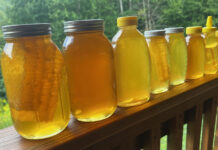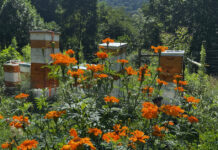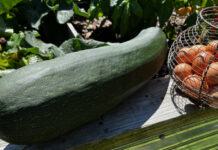Our 11 hens are now laying an average of seven eggs per day. That’s a definite improvement from just two weeks ago. I don’t know whether it is because of the summer solstice or just that the weather has improved and temperatures have risen to what we might consider “normal” for this time of year.
It’s been a cold and wet spring. I knew that was hurting the bees, but I wasn’t aware it was hurting the chickens. I thought they were just getting old, but age may be only one factor. Last year, we averaged almost one egg per hen per day.
How cold has it been? Well, we had our last fire on May 28th. That’s the latest we’ve ever had to burn wood to keep warm in the spring.
Our garden also got off to a slow start and some things that were direct seeded did not sprout, or only two plants came up. If this was a survival year, we’d be hungry.
Wet Versus Dry
I ran into a friend the other day and she joked about living in a rain forest. Some weeks it has felt that way. Still, when forced to choose between too much rain and too little, I’ll take too much.
Except for one day when we got two-and-a-half inches, most of the rainfall has been spread out and only a few days that were total wash outs. We’ve had close to five inches in one week. A friend on another mountain had seven inches that same week. Seven inches of rain spread out over a week is manageable. Seven inches in a day will cause a flood. The amount of water pouring down mountain streams remains elevated. It will be interesting to see if that remains the case in August, which is usually one of our dryer, hotter months.
For a while, it rained late at night. Then we had rain in the morning, tapering off before noon. As the temperatures rise, I think we are heading into the more common pattern of thunderstorm being a possibility almost every evening.
Micro Climates
The way the weather blows up and over the mountains, and how some mountain ridges run north and south and others go east and west, means our weather differs from someone a few miles away. Sometimes weather runs up or down one valley and misses a perpendicular valley. It just depends on wind direction. Altitude is also a factor, especially with temperatures and fog. We are far more likely to get socked in with fog than folks down in the valleys. When you are down there looking up, the fog is pretty. When you are socked in, there’s nothing pretty about it, but it does keep the temperatures down.
Whether you are on the south slope or the west slope will also affect your weather. We tend to get morning sun and not as much afternoon sun. People who get the hotter afternoon sun will find things ripen there before they do here. The tradeoff is that we get more sun in the winter and the snow on our slope melts faster than it does on the opposing one.
Garden Explosion
Just as the hens are laying more, the garden has exploded. The peas did so much climbing, I had to give them more poles to latch onto. Our beans are bush beans, but they also are putting on growth. The pepper plants are doing fine and the zucchini, which are the last thing we planted, have tripled in size in one week.
Our herb garden is also doing well. We harvested some dill already. My wife used some of it fresh and we dried the rest of it in our dehydrator. We’ll get another harvest or two from it.
The growth of flowers my wife planted in the raised beds as an experiment in companion planting have growth rates far exceeding the same flowers she planted elsewhere. Their size surprised her, and she had to transplant some of them elsewhere, so we would have room for the vegetables. It’s a good illustration of how the compost and other soil amendments we’ve added to the raised bed boosts production compared to topsoil. That’s an important lesson if we need to plant vegetables outside the garden confines in an attempt to raise more food post-SHTF. As a result, we are considering more raised beds.
This experience also demonstrates why it is important to have your garden in place before disaster strikes. Yes, everyone says that, but seeing is believing. We now have that valuable head start and our garden grows better every year.
Our compost pile is also growing, and the chickens help turn it when they are out free ranging. (It is one of the first places they head.) Still, I don’t think you can have too much compost if called upon to double or triple the size of your garden. The chicken poop makes it rich, but you have to wait months before you can use manure on your plants (rabbit manure is an exception).
More Chores
While the garden’s performance is welcome, the rapid growth of greenery means I had to go weed whack around the electric fence and in other strategic locations where we want to control weeds. When grass and weeds get too close and touch the electric fence wires, they ground it out, reducing the charge it carries. This is especially bad when it rains because a wet blade of grass transmits electricity better than a dry one. Our fence is powerful enough that it can burn through a few blades of grass. Wet grass, however, can cause problems. I cut the greenery back several feet from the fence line to avoid problems.
I’m just glad my back problems are in remission and I can swing the weed whacker without being in pain. With any luck, my back pain won’t come back for at least a year.
After the SHTF, I’ll sure miss my chiropractor.








